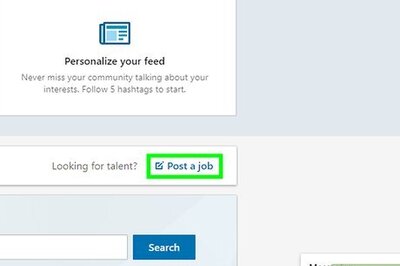
views
The Federal Reserve on Thursday rolled out an aggressive new strategy to restore the United States to full employment and lift inflation back to healthier levels in a world where it now believes that “downward risks to employment and inflation have increased.”
Under the new approach outlined by Fed Chair Jerome Powell in prepared remarks, the U.S. central bank will seek to achieve inflation averaging 2% over time, offsetting below-2% periods with higher inflation “for some time,” and to ensure employment doesn’t fall short of its maximum level.
Story:
HIGHLIGHTS:
* Fed’s new strategy, will target average inflation and put emphasis on “broad and inclusive” employment
* Fed places employment before inflation in new monetary policy strategy, says it will seek to ensure that employment does not fall short of its maximum level
* Fed: committee now seeks to achieve inflation that averages 2% over time, will offset periods of weak inflation with inflation above 2% for some period of time
* Fed: committee judges that the downward risks to employment and inflation have increased
* Fed: federal funds rate is likely to be constrained by its effective lower bound more frequently than in the past
* Fed: committee intends to undertake thorough review of monetary policy strategy roughly every five years
MARKET REACTION:
STOCKS: The S&P 500 e-mini futures briefly extended losses then moved 0.29% higher, pointing to a firmer open
BONDS: U.S. Treasury yields fell: 2s last at 0.1406; 10s at 0.6591%
FOREX: The U.S. dollar index turned lower and was last off 0.34%
COMMENTS:
ERNESTO RAMOS, MANAGING DIRECTOR, ACTIVE EQUITIES, BMO GLOBAL ASSET MANAGEMENT, CHICAGO
“This market these days is all driven by Fed liquidity and expectations for more or less Fed liquidity and you can see that so clearly this morning.”
“He reassured the market that there’s going to be continued liquidity and that’s when futures popped. The fact the market is so fixated on what Powell says tells me it’s really driven by what the Fed does or says and not by fundamentals.”
“We’ve seen this before and it usually does not end well but it’s almost impossible to forecast when it’s going to end.”
“When you have a liquidity driven market people are not pricing in fundamentals or buying stocks according to what the underlying pillars of growth are. Therefore when that liquidity gets taken away or the expectation is it will be taken away the whole house of cards collapses, Like any bubble you can sustain it for a while but you can’t sustain it forever.”
LUKE TILLEY, CHIEF ECONOMIST, WILMINGTON TRUST, WILMINGTON, DELAWARE
“I don’t see this as very much of a change in the Fed’s actual longer-term goals or even in their operating policy. I see this more as a big change in their communication about it. The idea that after you undershoot inflation that you would need to have periods that were above inflation, in my mind, has always been there, even from the original statement in 2012.”
“It’s helpful to markets because one of the things here is that inflation has been too low for a very long time. So any time inflation started to move up markets would get fearful, especially the bond market, that the Fed was going to hike…I think the market has come to view the Fed as very hawkish on inflation, and today’s statement is to push back against that and say that they will allow these higher periods of inflation.”
“This announcement this morning is essentially the death of the Phillips curve. Over the past couple of years when the unemployment rate went down to 3.5% and everybody thought, ‘Well, isn’t that supposed to generate inflation?’ Then it didn’t. The changes to the language around letting the labor market have those bigger deviations is reinforcing the idea that we don’t really believe in the Phillips curve as a good predictor of inflation anymore.”
ROBERTO PERLI, PARTNER AND HEAD OF GLOBAL POLICY RESEARCH, CORNERSTONE MACRO, WASHINGTON
“What’s missing here is an articulation of how exactly we’re going to get higher inflation. Even the statement of longer-run goals just says we’re going to use all of our tools. But it sounds like the tools are going to be the old tools and those old tools were not successful in producing higher inflation in the past. So why should they be successful this time around?”
TOM DI GALOMA, MANAGING DIRECTOR, SEAPORT GLOBAL HOLDINGS, NEW YORK
“They would like to target a higher inflation rate, but obviously he (Powell) needs to see it first.”
“We were at 1.41% on the 30-year before he spoke. Now we’re around 1.37%. It seems to me that everyone was looking for a steeper curve after the Fed spoke, and we’re not getting it.”
“He’s kind of disappointed on the inflation front. People were looking for an inflation target above 2%. That’s why the market rallied.”
EDWARD MOYA, SENIOR MARKET ANALYST, OANDA, NEW YORK
“It’s all about inflation…we did see equities pop higher, gold also turned positive on his comments on inflation, just knowing they can overshoot their target. I think it pretty much confirmed the market expectations that this extreme level of accommodation is not going away any time soon, and risky assets are liking that.”
“The dollar is going to be the punching bag again. We saw a little bit of a tentative pause in the dollar weakening trade, and now it just seems that over the next few years we’re going to have the economic recovery hopefully pick up, and what’s going to happen is when you have all the other central banks starting to pull back their stimulus, starting to show signs of tightening, the Fed is going to lag on that, and you’re going to see that interest rate differential not be in the dollar’s favor. It’s just providing a longer-term bearish outlook for the greenback.”
(Compiled by Alden Bentley and global Finance & Markets Breaking News team)
Disclaimer: This post has been auto-published from an agency feed without any modifications to the text and has not been reviewed by an editor



















Comments
0 comment